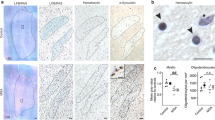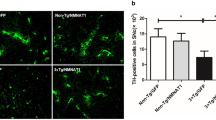Abstract
Multiple system atrophy (MSA) is a sporadic neurodegenerative disorder characterized by striatonigral degeneration and olivopontocerebellar atrophy. The main hallmark of MSA is the aggregation of alpha-synuclein in oligodendrocytes, which contributes to the dysfunction and death of the oligodendrocytes, followed by neurodegeneration. Studies suggested that oxidative-excitatory pathway is associated with the progression of the disease. The aim of the current study was to test this concept by overexpression of excitatory amino acid transporter 2, glutamate dehydrogenase and nuclear factor (erythroid-derived 2)-related factor 2 genes in the striatum of two established mouse models of MSA. To induce the first model, we injected the mitochondrial neurotoxin, 3-nitropropionic acid (3-NP), unilaterally into the right striatum in 2-month-old C57BL/6 male mice. We demonstrate a significant improvement in two drug-induced rotational behavior tests, following unilateral injection the three genes. For the second model, we used transgenic mice expressing the alpha-synuclein gene under the proteolipid protein, in the age of 7 months, boosted with 3-NP to enhance the motor deficits and neurodegeneration. We show that the overexpression of the three genes attenuated the motor-related deficit in the elevated bridge and pole tests. Thus, our study indicates that glutamate excito-oxidative toxicity plays a major role in this MSA model and our gene therapy approach might suggest a novel strategy for MSA treatment.



Similar content being viewed by others
References
Ahmed Z, Asi YT, Sailer A, Lees AJ, Houlden H, Revesz T, Holton JL (2012) The neuropathology, pathophysiology and genetics of multiple system atrophy. Neuropathol Appl Neurobiol 38:4–24
Barca E, Kleiner G, Tang G, Tadesse S, Lin C-Y, Masliah E, Kuo S-H, Hirano CQ (2016) Decreased coenzyme Q10 levels in multiple system atrophy cerebellum (P4.304). Neurology 86:P4.304
Beal MF, Brouillet E, Jenkins BG, Ferrante RJ, Kowall NW, Miller JM, Storey E, Srivastava R, Rosen BR, Hyman BT (1993) Neurochemical and histologic characterization of striatal excitotoxic lesions produced by the mitochondrial toxin 3-nitropropionic acid. J Neurosci 13:4181–4192
Benkler C, Barhum Y, Ben-Zur T, Offen D (2016) Multifactorial gene therapy enhancing the glutamate uptake system and reducing oxidative stress delays symptom onset and prolongs survival in the SOD1-G93A ALS mouse model. J Mol Neurosci 58:46–58
Coyle J, Puttfarcken P (1993) Oxidative stress, glutamate, and neurodegenerative disorders. Science 262:689–695
Duvoisin RC, Chokroverty S, Lepore F, Nicklas W (1983) Glutamate dehydrogenase deficiency in patients with olivopontocerebellar atrophy. Neurology 33:1322–1326
Giasson BI, Duda JE, Murray IV, Chen Q, Souza JM, Hurtig HI, Ischiropoulos H, Trojanowski JQ, Lee VM, Markesbery WR, Carney JM, Jenner P, Olanow CW, Cookson MR, Shaw PJ, Browne SE, Ferrante RJ, Beal MF et al (2000) Oxidative damage linked to neurodegeneration by selective alpha-synuclein nitration in synucleinopathy lesions. Science 290:985–989
Glat MJ, Ben-Zur T, Barhum Y, Offen D (2016) Neuroprotective effect of a DJ-1 based peptide in a toxin induced mouse model of multiple system atrophy. PLoS One 11:e0148170
Guo H, Lai L, Butchbach MER, Stockinger MP, Shan X, Bishop GA, Lin CG (2003) Increased expression of the glial glutamate transporter EAAT2 modulates excitotoxicity and delays the onset but not the outcome of ALS in mice. Hum Mol Genet 12:2519–2532
Hanna PA, Jankovic J, Kirkpatrick JB (1999) Multiple system atrophy: the putative causative role of environmental toxins. Arch Neurol 56:90–94
Hybertson BM, Gao B, Bose SK, McCord JM (2011) Oxidative stress in health and disease: the therapeutic potential of Nrf2 activation. Mol Aspects Med 32:234–246
Kikuchi A, Takeda A, Onodera H, Kimpara T, Hisanaga K, Sato N, Nunomura A, Castellani RJ, Perry G, Smith MA, Itoyama Y (2002) Systemic increase of oxidative nucleic acid damage in Parkinson’s disease and multiple system atrophy. Neurobiol Dis 9:244–248
Kim GW, Copin JC, Kawase M, Chen SF, Sato S, Gobbel GT, Chan PH (2000) Excitotoxicity is required for induction of oxidative stress and apoptosis in mouse striatum by the mitochondrial toxin, 3-nitropropionic acid. J Cereb Blood Flow Metab 20:119–129
Luong TN, Carlisle HJ, Southwell A, Patterson PH (2011) Assessment of motor balance and coordination in mice using the balance beam. J Vis Exp. https://doi.org/10.3791/2376
Mastorodemos V, Zaganas I, Spanaki C, Bessa M, Plaitakis A (2005) Molecular basis of human glutamate dehydrogenase regulation under changing energy demands. J Neurosci Res 79:65–73
Matute C, Alberdi E, Domercq M, Sánchez-Gómez M-V, Pérez-Samartín A, Rodríguez-Antigüedad A, Pérez-Cerdá F (2007) Excitotoxic damage to white matter. J Anat 210:693–702
Molcho L, Ben-Zur T, Barhum Y, Angel A, Glat M, Offen D (2018) Combined gene therapy to reduce the neuronal damage in the mouse model of focal ischemic injury. J Mol Neurosci 66(2):180–187
Molz S, Decker H, Dal-Cim T, Cremonez C, Cordova FM, Leal RB, Tasca CI (2008) Glutamate-induced toxicity in hippocampal slices involves apoptotic features and p38MAPK signaling. Neurochem Res 33:27–36
Nagai N, Thimmulappa RK, Cano M, Fujihara M, Izumi-Nagai K, Kong X, Sporn MB, Kensler TW, Biswal S, Handa JT (2009) Nrf2 is a critical modulator of the innate immune response in a model of uveitis. Free Radic Biol Med 47:300–306
Nagesh Babu G, Gupta M, Paliwal VK, Singh S, Chatterji T, Roy R (2018) Serum metabolomics study in a group of Parkinson’s disease patients from northern India. Clin Chim Acta 480:214–219
Overk C, Rockenstein E, Valera E, Stefanova N, Wenning G, Masliah E (2018) Multiple system atrophy: experimental models and reality. Acta Neuropathol 135:33–47
Pang Z, Geddes JW (1997) Mechanisms of cell death induced by the mitochondrial toxin 3-nitropropionic acid: acute excitotoxic necrosis and delayed apoptosis. J Neurosci 17:3064–3073
Plaitakis A, Berl S, Yahr MD (1982) Abnormal glutamate metabolism in an adult-onset degenerative neurological disorder. Science 216:193–196
Refolo V, Bez F, Polissidis A, Kuzdas-Wood D, Sturm E, Kamaratou M, Poewe W, Stefanis L, Angela Cenci M, Romero-Ramos M, Wenning GK, Stefanova N (2018) Progressive striatonigral degeneration in a transgenic mouse model of multiple system atrophy: translational implications for interventional therapies. Acta Neuropathol Commun 6:2–10
Rial D, Castro AA, Machado N, Garçã OP, Gonçalves FQ, Silva HB, Tomé NR, Kö Falvi A, Corti O, Raisman-Vozari R, Cunha RA, Prediger RD (2014) Behavioral phenotyping of parkin-deficient mice: looking for early preclinical features of Parkinson’s disease. PLoS One. https://doi.org/10.1371/journal.pone.0114216
Rojo AI, Innamorato NG, Martín-Moreno AM, De Ceballos ML, Yamamoto M, Cuadrado A (2010) Nrf2 regulates microglial dynamics and neuroinflammation in experimental Parkinson’s disease. Glia 58:588–598
Stefanova N, Reindl M, Neumann M, Haass C, Poewe W, Kahle PJ, Wenning GK (2005) Oxidative stress in transgenic mice with oligodendroglial α-synuclein overexpression replicates the characteristic neuropathology of multiple system atrophy. Am J Pathol 166:869–876
Ubhi K, Lee PH, Adame A, Inglis C, Mante M, Rockenstein E, Stefanova N, Wenning GK, Masliah E (2009) Mitochondrial inhibitor 3-nitropropionic acid enhances oxidative modification of alpha-synuclein in a transgenic mouse model of multiple system atrophy. J Neurosci Res 87:2728–2739
Vanacore N (2005) Epidemiological evidence on multiple system atrophy. J Neural Transm 112:1605–1612
Vargas MR, Johnson JA (2009) The Nrf2-ARE cytoprotective pathway in astrocytes. Expert Rev Mol Med 11:e17
Waldner R, Puschban Z, Scherfler C, Seppi K, Jellinger K, Poewe W, Wenning GK (2001) No functional effects of embryonic neuronal grafts on motor deficits in a 3-nitropropionic acid rat model of advanced striatonigral degeneration (multiple system atrophy). Neuroscience 102:581–592
Wenning GK, Stefanova N, Jellinger KA, Poewe W, Schlossmacher MG (2008) Multiple system atrophy: a primary oligodendrogliopathy. Ann Neurol 64:239–246
Acknowledgements
This study received funds as a scholarship from Mr. Martin Davis, a private donor. The funders had no role in study design, data collection and analysis, decision to publish, or the preparation of the manuscript.
Funding
None.
Author information
Authors and Affiliations
Contributions
Research project: MG, NS, GW and DO. Statistical analysis: MG. Manuscript: writing of the first draft—MG. Review and critique: GW, NS and DO. Intellectual property rights: DO and Tel Aviv University.
Corresponding author
Ethics declarations
Conflict of interest
DO and MG hold patents related to gene therapy in neurodegenerative diseases. NS and GW have nothing to disclose.
Additional information
Publisher's Note
Springer Nature remains neutral with regard to jurisdictional claims in published maps and institutional affiliations.
Rights and permissions
About this article
Cite this article
Glat, M.J., Stefanova, N., Wenning, G.K. et al. Genes to treat excitotoxicity ameliorate the symptoms of the disease in mice models of multiple system atrophy. J Neural Transm 127, 205–212 (2020). https://doi.org/10.1007/s00702-020-02158-2
Received:
Accepted:
Published:
Issue Date:
DOI: https://doi.org/10.1007/s00702-020-02158-2




